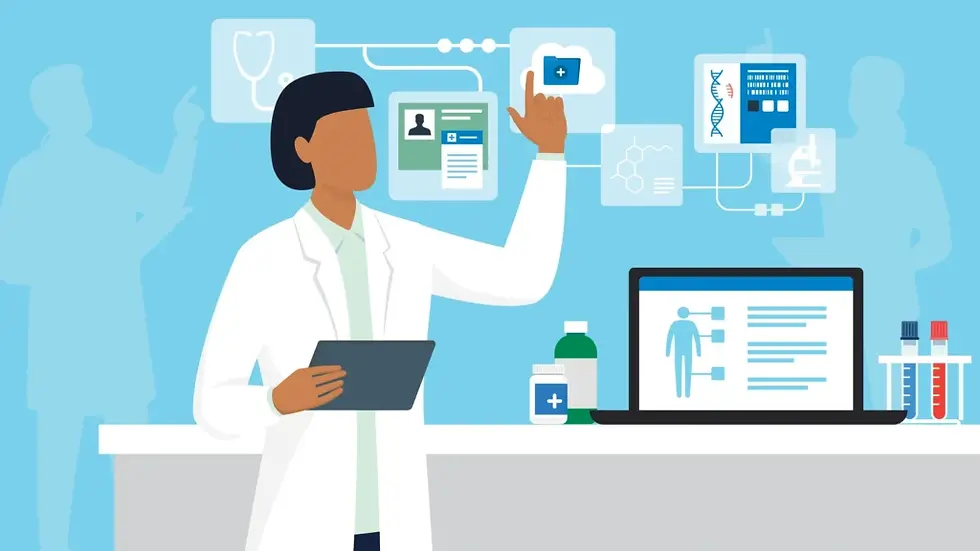The Internet of Healthy Things Redux: Chapter 3, The Big Shake-Up*
- Apr 20
- 4 min read
Updated: Nov 21
*Thanks to Tara Menon and Gina Cella for their help in editing this piece
This year, I have been blogging about the 10th anniversary of my book, The Internet of Healthy Things (IoHT). While taking a trip down memory lane, it has been fun to:
Assess how well my coauthors and I did in predicting the future.
Wonder what people we interviewed are doing now.
Recall the companies we highlighted and wonder where they are today.
This motivated me to commit to posting about a different chapter regularly throughout the year and to ask you, my valued readers, to grade us.
If you haven’t had a chance to read the first two installments, you may do so here (but go ahead and finish this one first!).
This month, I tackle Chapter 3, The Big Shakeup. This chapter is about the push in the U.S. for value-based (VB) reimbursement strategies. Our thought (hope, really) was that there would be an increase in reimbursement mechanisms that pay healthcare providers for quality and outcomes rather than units of service, typically referred to as fee-for-service (FFS) reimbursement. Our enthusiasm for VB policies stemmed from two beliefs. The first is that FFS payments are primarily responsible for the outsized U.S. healthcare expenditures ($4.9 trillion as of 2023, or 17.6% of GDP). The second is that VB policies provide a much riper environment for the devices, apps, and programs we discussed in IoHT.
How did these two hypotheses play out? Here is the tl;dr: VB care has grown as a percentage of overall reimbursements. FFS policies still dominate, particularly on the inpatient side, where much of our expenditures happen. Most growth in telehealth implementations has been from new reimbursement codes (FFS), and I don’t find much evidence that VB policies correlate with increased telehealth implementations. I’ll speculate on why things turned out the way they did.
VB Reimbursement Growth
In 2015, the Centers for Medicare and Medicaid Services (CMS), the largest payer in the U.S., set a goal that 90% of their reimbursements would be VB by 2018. Our assumptions in this chapter were based on that push. We later learned that prediction included hospital-based diagnosis-related group (DRG) reimbursement grouping inpatient charges from facilities, which have not changed much since 1983. Which begs the question, what is the current mix of VB vs FFS? The answer can get complex quickly, but here is a high-level look. Just over 50% of Medicare enrollees are in Medicare Advantage plans. Of the remainder, 53% are in VB programs with their providers. So that accounts for about 75% (not 90%). Medicaid has had a steady increase in VB contracts in the ensuing decade, but according to what I can find, about 3% of Medicaid insured are in a VB world (if you have better data, please share). Finally, the best data I could come up with on the employer-sponsored sector is that 16.5% of commercial payments were VB in 2023. It is also worth noting that CMS recently announced it will end the Medicare Advantage Value-Based Insurance Design (VBID) model after 2025 due to high costs and limited savings. This is a significant signal that even the most ambitious VB experiments face real challenges in delivering cost reductions and quality improvements. Whatever lens you apply, the penetration of VB reimbursement has stalled.
Has VB Growth Correlated With More Use of IOT Technologies?
The answer to this one is complicated by two phenomena that we couldn’t predict in 2015:
1. The advent of reimbursement codes for remote physiologic monitoring (RPM) and remote therapeutic monitoring (RTM)
2. The need for home monitoring of patients with COVID-19 during the pandemic.
To answer this one, I’ll rely on personal experience, as a board member of an RPM company from 2019-2022. Before reimbursement codes, the market was small, and the companies all struggled. I found one citation stating that the market size for RPM 2015 was $294M. Medicare introduced RPM reimbursement codes in 2018; by 2023, the market size estimate was $15.8B. My sense is that very little of this had to do with the adoption of VB payment models and was more a function of the two confounders noted above.
So, for this chapter, I’d give my coauthors and me a C-. We were overly optimistic about the rise in VB payments and even more optimistic that those paid in VB contracts would see the value of telehealth programs. The term that comes to mind is “irrational exuberance.”
Here’s the part where I get to speculate about why things turned out the way they did. The adoption of VB care is like a game of chicken. Healthcare providers need payers, and payers need providers. If either group pushes too hard on anything financial, the other side can rebel and upset the delicate equilibrium. Thus, when it gets to the clinician level, most VB models are so watered down they do very little to affect behavior change. A compelling example is that providers take only upside risk (the core of their pay is still based on FFS, but if they meet specific financial targets, they get a bonus; if they don’t meet those targets, though, they take no penalty) — hardly a way to change provider behavior. In this context, the world of IoHT is somewhere between a curiosity and a distraction.

The other wild card is the overwhelming demand for healthcare services. All clinicians are stretched, with full waiting rooms and long wait times for the next available appointment, and complete EHR notes at night after their children have gone to bed. Thus, any new monitoring programs just create another stressor. Before the 2018 reimbursement codes, employing a non-physician clinician to call patients between visits was a much more popular way to promote quality or lower hospital readmissions than employing what we called “connected health” a decade ago.
The bottom line is that traditional US healthcare delivery is like the Titanic. Getting this giant albatross to change course is much harder than it looks.
Am I too negative? What are your thoughts? Are there conflicting data you’d like to share?






Comments